Comparing Interpretations Questions (Edexcel GCSE History): Revision Note
Exam code: 1HI0
Summary of Question 3 (b)
Question 3 (b) asks you to explain the difference between Interpretation 1 and Interpretation 2
The interpretations used in Question 3 (b) will be the same interpretations used in Questions 3 (c) and (d)
Amount of marks | 4 |
|---|---|
The time that you should spend on the question | No more than 5 minutes |
An example of the type of question you may encounter can be seen below:
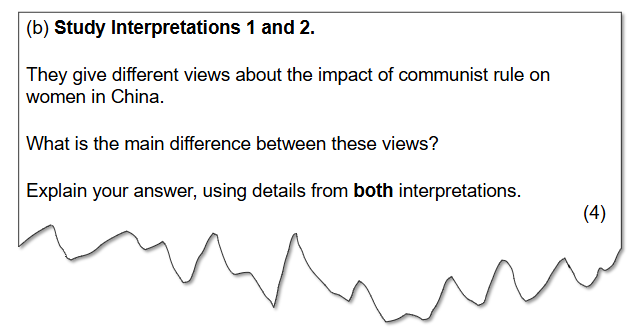
In previous years, this question has focused on the following topics in Mao's China:
Year of Exam
Question Topic
2018
Reasons for the success of the CCP in the Civil War (opens in a new tab)
2019
The effects of the Cultural Revolution (opens in a new tab)
2020
Achievements of the First Five-Year Plan (opens in a new tab)
2021
No paper available
2022
Causes of the Great Famine (1958–62) (opens in a new tab)
2023
Reasons for the Cultural Revolution (opens in a new tab)
2024
Healthcare reforms in Mao’s China
What is an interpretation question?
An interpretation is someone’s point of view about a historical event, person or time period
Interpretations focus on different ideas or evidence, so they may not always agree
These interpretations could be written:
After the event
By people who were there at the time
By historians
You will be given two interpretations from the Sources/ Interpretations Booklet
This is a separate booklet from your answer paper
It includes the key interpretations you’ll need for Section B
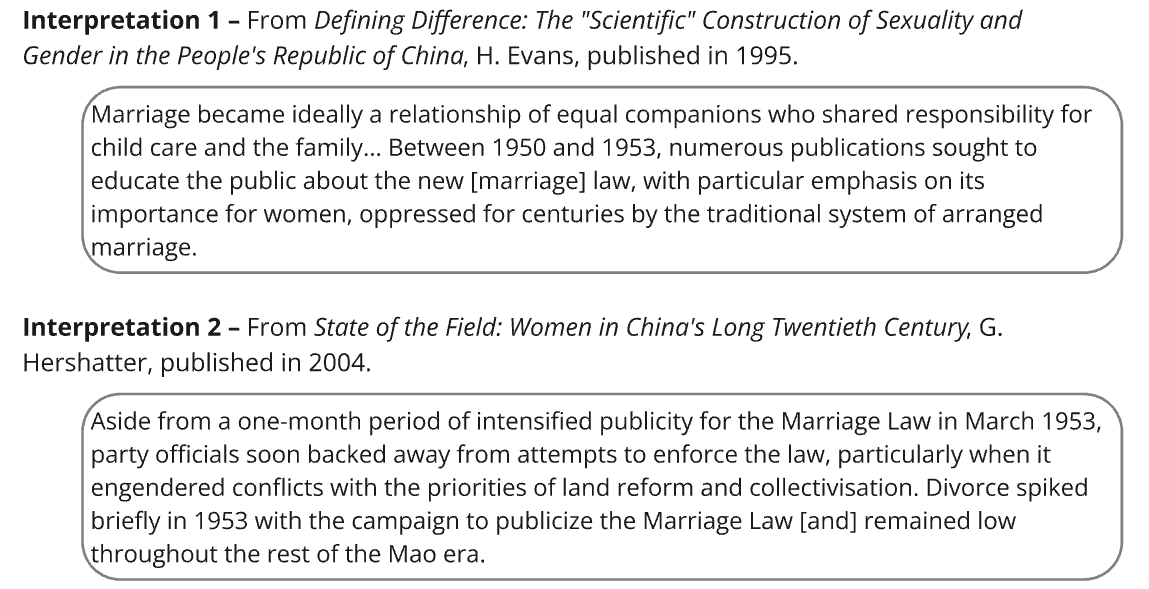
Question 3 (b) — "What is the main difference?"
The interpretations used in Question 3 (b) will always be different from one another
In the Edexcel Mao's China, 1945–76, interpretations are different based on the following themes:
Political developments (e.g. CCP policies)
Social and cultural developments (e.g. the Cultural Revolution)
Economic developments (e.g. the effects of the Great Leap Forward)
"What is the main difference?" question structure
Your answer needs to:
Identify and explain the main difference in content between Interpretation 1 and Interpretation 2 (In)
Support your explanation with a short quote or clear summary from each interpretation (In)
To achieve full marks, you need to include both Interpretation 1 and Interpretation 2 in your answer
Worked example of a "What is the main difference?" question
Worked Example
3 (b) Study Interpretations 1 and 2. They give different views about the impact of Communist rule on women in China.
What is the main difference between these views?
Explain your answer, using details from both interpretations.
(4)
![Interpretation 1 — From Defining Difference: The "Scientific" Construction of Sexuality and Gender in the People's Republic of China, H. Evans, published in 1995.
"Marriage became ideally a relationship of equal companions who shared responsibility for child care and the family ... Between 1950 and 1953, numerous publications sought to educate the public about the new [marriage] law, with particular emphasis on its importance for women, oppressed for centuries by the traditional system of arranged marriage."
Interpretation 2 — From State of the Field: Women in China's Long Twentieth Century, G. Hershatter, published in 2004.
"Aside from a one-month period of intensified publicity for the Marriage Law in March 1953, party officials soon backed away from attempts to enforce the law, particularly when it engendered conflicts with the priorities of land reform and collectivisation. Divorce spiked briefly in 1953 with the campaign to publicize the Marriage Law [and] remained low throughout the rest of the Mao era."](https://cdn.savemyexams.com/cdn-cgi/image/f=auto,width=3840/https://cdn.savemyexams.com/uploads/2025/08/44587_httpscdn-savemyexams-comuploads2025085955-httpscdn-savemyexams-comuploads20250727939-interpretations-china.png)
Answer:
The main difference between the interpretations is whether the Communist Party's policies concerning women were successful (In). Interpretation 1 argues that women’s lives improved under Mao. It says that the Marriage Law (1950) helped women who had been "oppressed for centuries by the traditional system of arranged marriage" (In). Interpretation 2, on the other hand, argues that changes for women were limited and not strongly enforced (In). It says that Party officials "backed away from attempts to enforce the law" and that divorce "remained low throughout the rest of the Mao era" (In).
Summary of Question 3 (c)
Question 3 (c) asks you to explain why the interpretations are different
You should not repeat what you have written in Question 3 (b)
The interpretations used in Question 3 (c) will be the same interpretations used in Questions 3 (b) and (d)
You can use Sources B and C in this question
However, if you choose not to use them, you can still receive full marks
Amount of marks | 4 |
|---|---|
The time that you should spend on the question | No more than 5 minutes |
An example of the type of question you may encounter can be seen below:
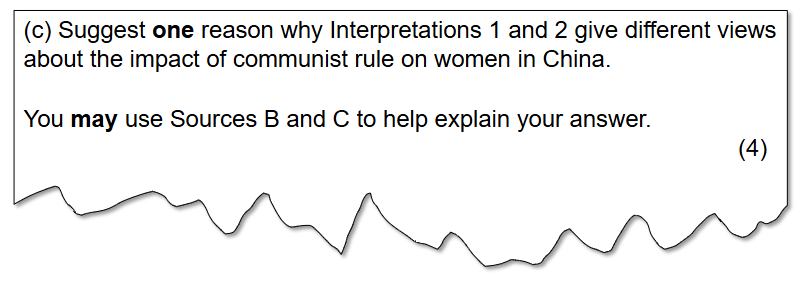
In previous years, this question has focused on the following topics in Mao's China:
Year of Exam
Question Topic
2018
Reasons for the success of the CCP in the Civil War (opens in a new tab)
2019
The effects of the Cultural Revolution (opens in a new tab)
2020
Achievements of the First Five-Year Plan (opens in a new tab)
2021
No paper available
2022
Causes of the Great Famine (1958–62) (opens in a new tab)
2023
Reasons for the Cultural Revolution (opens in a new tab)
2024
Healthcare reforms in Mao’s China
Question 3 (c) — "Why are interpretations different?"
Interpretation 1 and Interpretation 2 may have different interpretations due to:
The types of sources they have used
For example, some interpretations may have placed more weight on political sources whereas others may use more economic sources
The authors' focus on short-, medium- or long-term developments or effects
For example, some interpretations may have focused on the short-term effects of an event, such as the First Five-Year Plan
Others may focus on the long-term effects
Do not refer to provenance
You will not receive any marks for an explanation focused on provenance
"Why are the interpretations different?" question structure
The most common way of structuring this answer is by using Sources B and C
One of the sources will support the argument made in Interpretation 1
The remaining source will agree with the argument given in Interpretation 2
Do not use Source A in your answer as you will not receive any marks
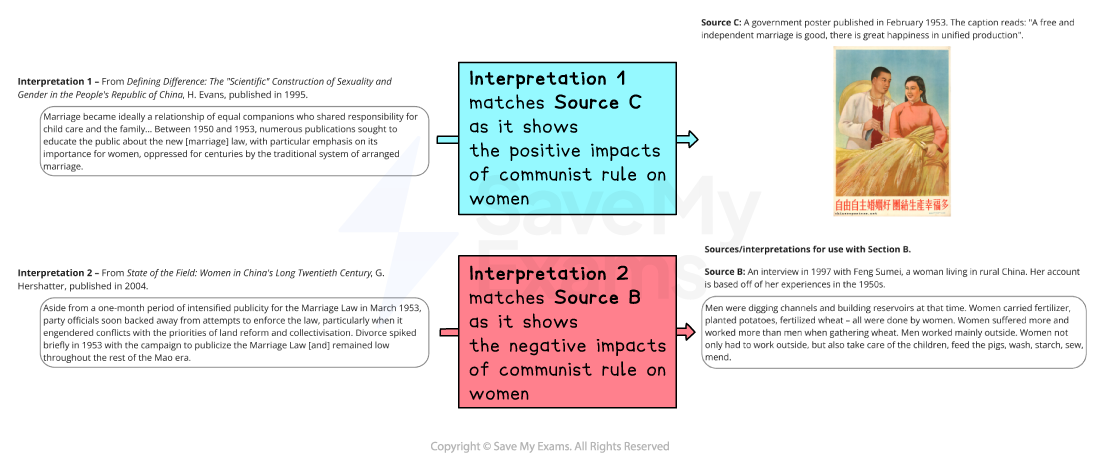
Using this method, you would use the following structure in your answer:
State that historians' viewpoints differ because they have given weight to different sources (In)
For Interpretation 1, state that they have looked at sources such as Interpretation 1's matching source (either Source B or C)
Use quotes or details from the source and from Interpretation 1 to show how they connect (In)
Repeat this structure for Interpretation 2, using its matching source
Do not use irrelevant information from the interpretations that are not based on the question
For example, a student may focus on the mention of land reform in Interpretation 2 and discuss the CCP's policies on land
This is not relevant and will not receive marks
Worked example of a "Why are the interpretations different?" question
Worked Example
3 (c) Suggest one reason why Interpretations 1 and 2 give different views about the impact of Communist rule on women in China.
You may use Sources B and C to help explain your answer.
(4)
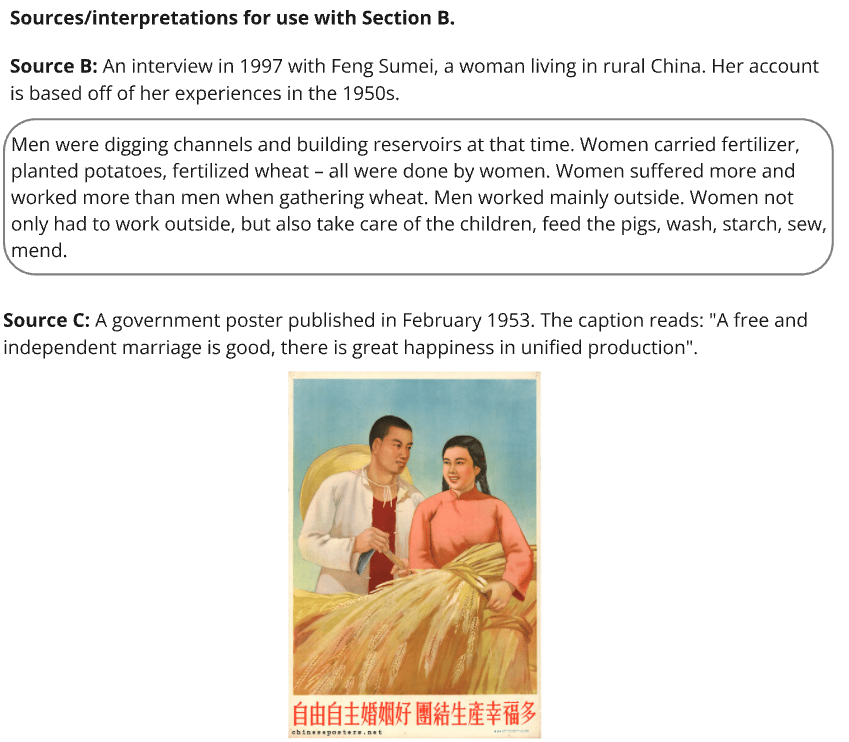
![Interpretation 1 — From Defining Difference: The "Scientific" Construction of Sexuality and Gender in the People's Republic of China, H. Evans, published in 1995.
"Marriage became ideally a relationship of equal companions who shared responsibility for child care and the family... Between 1950 and 1953, numerous publications sought to educate the public about the new [marriage] law, with particular emphasis on its importance for women, oppressed for centuries by the traditional system of arranged marriage."
Interpretation 2 — From State of the Field: Women in China's Long Twentieth Century, G. Hershatter, published in 2004.
"Aside from a one-month period of intensified publicity for the Marriage Law in March 1953, party officials soon backed away from attempts to enforce the law, particularly when it engendered conflicts with the priorities of land reform and collectivisation. Divorce spiked briefly in 1953 with the campaign to publicize the Marriage Law [and] remained low throughout the rest of the Mao era."](https://cdn.savemyexams.com/cdn-cgi/image/f=auto,width=3840/https://cdn.savemyexams.com/uploads/2025/08/33179_httpscdn-savemyexams-comuploads20250727939-interpretations-china.png)
Answer:
Interpretations 1 and 2 give different views because they have given weight to different sources (In). The author of Interpretation 1 will have considered historical sources such as Source C. Source C is a government poster showing a smiling couple holding hands and includes the caption: "A free and independent marriage is good." This supports what is said in Interpretation 1, as it is claimed that "marriage became ideally a relationship of equal companions" (In). However, Interpretation 2 will have studied sources such as Source B. Source B describes how women in the 1950s "not only had to work outside but also take care of the children". This supports what Interpretation 2 argues insofar as in rural areas, "party officials soon backed away from attempts to enforce" marriage equality because it could interfere with "the priorities of land reform and collectivisation" (In).

Unlock more, it's free!
Did this page help you?